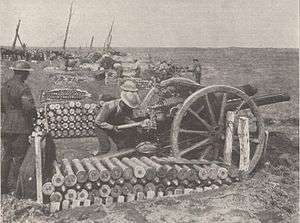Artillery of World War I

The artillery of World War I was used primarily to counter the trench warfare that set in shortly after the conflict commenced, and was an important factor in the war, influencing its tactics, and operations, and being incorporated into strategies that were used by the belligerents to break the stalemate at the front. World War I raised artillery to a new level of importance on the battlefield.
The First World War saw several developments in artillery warfare. Artillery could now fire the new high explosive shells, and throw them farther and at a higher rate of fire. Because of this, enemies in trenches were no longer always safe, and could constantly be fired upon. In some areas, artillery concentration was common, with several guns firing onto an area such as a line of trenches, each gun firing several rounds per minute for hours. Artillery barrages were also used before an infantry battle, to distract the enemy away from the place of attack, or the paths behind the lines were fired on so that enemy reinforcements were not able to reach the area without getting hit.
Mortars were revived by the Germans because of their ability to shoot at an angle above 45 degrees, and they, therefore, could theoretically (although not often) drop shells directly in an enemy's trench before exploding, for maximum damage.[1] Artillery shells were used for gas release by the German troops in 1915, and the Allies followed their example after the Second Battle of Ypres.
Allied Powers Artillery
- 42-line field gun M1877
- BL 6-inch 26 cwt howitzer
- 76 mm gun M1900
- Cannone da 65/17 modello 13
- Cannone da 75/27 modello 06
- Canon d'Infanterie de 37 modèle 1916 TRP
- Canon de 105 mle 1913 Schneider
- Canon de 155 C modèle 1917 Schneider
- Canon de 155mm GPF
- Canon de 75 modèle 1897
- Canon de 155 L modèle 1877/14 Schneider
- De Bange 90 mm cannon
- Lahitolle 95 mm cannon
- BL 12-inch railway howitzer
- BL 9.2-inch howitzer
- BL 12-inch howitzer
- BL 60-pounder gun
- Ordnance QF 18-pounder
- QF 4.7-inch Gun Mk I–IV
- 3-inch M1902 field gun
Central Powers Artillery
Methods
The artillery Arm developed several new methods and tactics of combat during the war, including:
- Box barrage
- Chinese barrage
- Clock method of calling fall of shot[2]
- Creeping barrage
- Artillery sound ranging
See also
Notes
- ↑ "First World War.com - Weapons of War: Trench Mortars". www.firstworldwar.com. Archived from the original on May 3, 2012. Retrieved April 22, 2012.
- ↑ p.26, Rawlings
References
External links

- Storz, Dieter: Artillery , in: 1914-1918-online. International Encyclopedia of the First World War.
- Audoin-Rouzeau, Stéphane: Weapons , in: 1914-1918-online. International Encyclopedia of the First World War.
- Royal Engineers: Field Survey Companies
- Defence Surveyors Association
- Kloot, William van der; Lawrence Bragg’s Role in the Development of Sound-Ranging in World War I 2005 Royal Society (London), Notes & Records
- Lupfer, Timothy T; The Dynamics of Doctrine: The Change in German Tactical Doctrine during the First World War 1981 Combat Studies Institute, Combat Studies Institute, U.S. Army Command and General Staff College, Fort Leavenworth, Kansas
- List and pictures of World War I surviving guns